Items Similar to Tyrannosaurus Rex Tooth in Fossil Matrix
Want more images or videos?
Request additional images or videos from the seller
1 of 9
Tyrannosaurus Rex Tooth in Fossil Matrix
About the Item
Tyrannosaurus Rex Tooth in Fossil Matrix.
Late Cretaceous, circa 65 Million years before present.
Lance Formation, Marchant Ranch Quarry, Niobrara County, Wyoming. Collected under lease by Western Paleo of Salt Lake City in 1992.
An incredibly rich fossil matrix, with a large Tyrannosaurus rex tooth surrounded by the jumbled remains of two herbivorous dinosaurs, Edmontosaurus and Ankylosaurus, as well as several other terrestrial and aquatic animals. An aesthetic presentation preserving a cross-section of life immediately preceding the extinction event that killed the dinosaurs.
Found in the Lance Formation in the western USA, this fossil matrix gives an incredible insight into the creatures that roamed the earth at the end of the Late Cretaceous period. Most prominently displayed is the tooth of a near adult sized Tyrannosaurus rex, with its immaculately preserved serrated edges. This tooth would have come from the back half of the T. rex jaw - a jaw which, at the height of adulthood, would have held over 60 such saw-edged teeth and was easily capable of crushing bone. The matrix has also captured the teeth and numerous parts of ossified tendons from one or possibly several hadrosaurs (duck-billed dinosaurs), most likely Edmontosaurus. A large piece of bone at the base of the block is likely the scapula, or shoulder blade of an Edmontosaurus. On the reverse, there is a worn tooth from an ankylosaur (the armoured dinosaurs), probably belonging to an Ankylosaurus.
Beyond the dinosaurs, other animals are also present. In the centre of the block, there is part of the left jaw of a small mammal bearing a molar, as well as multiple fragments of terrapin plastron (the bottom side of the shell that lies beneath the abdomen). One has a stippled surface, displaying the outside texture of the plastron, whereas another is turned over so the smooth side is visible. The matrix also bears a single, small crocodile tooth, as well as several enamel-covered scales from gar fish and other aquatic creatures.
These fossilised specimens are held together by a mixture of sand, mud, and pebbles which is likely the result of a fluvial process, as is the case for almost all dinosaur fossils from the Hell Creek and Lance Formations. These creatures most likely died on a floodplain, where flood waters later washed them downstream into a high energy environment, before they settled and were buried. This resulted in the preservation of land animals alongside freshwater creatures.
Providing a rich and varied summary of life 65 million years ago, this matrix displays the remnants of at least three dinosaurs, a mammal, a turtle, a crocodile, and multiple fish. A remarkable artefact offering an incredible insight into life at the end of the reign of the dinosaurs.
- Dimensions:Height: 10.79 in (27.4 cm)Diameter: 8.67 in (22 cm)
- Materials and Techniques:
- Period:
- Date of Manufacture:Cretaceous, circa 65 Million years before present
- Condition:Wear consistent with age and use.
- Seller Location:London, GB
- Reference Number:1stDibs: LU1052238113532
About the Seller
5.0
Recognized Seller
These prestigious sellers are industry leaders and represent the highest echelon for item quality and design.
Established in 2008
1stDibs seller since 2014
100 sales on 1stDibs
Typical response time: 8 hours
Associations
LAPADA - The Association of Arts & Antiques DealersInternational Confederation of Art and Antique Dealers' AssociationsThe British Antique Dealers' Association
- ShippingRetrieving quote...Ships From: London, United Kingdom
- Return PolicyA return for this item may be initiated within 14 days of delivery.
More From This SellerView All
- Iridescent Ammonite FossilLocated in London, GBLarge spectacular iridescent ammonite fossil. 75 Million y/o A magnificent example of one of the most spectacular fossils. A large and int...Category
Antique 15th Century and Earlier Canadian Natural Specimens
MaterialsStone
- Petrified Incense Cedar Wood FossilLocated in London, GBThis spectacular cross section of petrified cedar wood comes from Saddle Mountain, Washington. It is remarkably large with a wonderful and highly aesthetic shape, exhibiting vibrant ...Category
Antique 15th Century and Earlier Natural Specimens
MaterialsPetrified Wood
- Large Leaf Fossil from the Green River FormationLocated in London, GBA large and beautifully preserved fossilised leaf from the Green River formation, a site which has brought forth some of the best-preserved fossi...Category
Antique 15th Century and Earlier North American Wall-mounted Sculptures
MaterialsOther
- Exceptional Egyptian Sarcophagus MaskLocated in London, GBExceptionally Fine Wooden Sarcophagus Mask Third Intermediate Period, 21st Dynasty, circa 1069-945 BC. Acacia wood, rosewood, hippopotamus ivory Masterfully carved from a single piece of fine-grained hardwood, the present mask is characteristic of the most exquisite funerary art made during the 21st Dynasty, and was probably commissioned for a particularly high-ranking individual. The oval face displays a gently smiling mouth with full, outlined lips, furrows at the corners and a bow-shaped philtrum. The straight nose with rounded nostrils, the cheeks full and fleshy and the large, almond shaped eyes with heavy lids and tapering cosmetic lines, set below long, sweeping eyebrows. Social collapse across the Mediterranean in the Late Bronze Age meant that the 21st Dynasty in Egypt was a period of great turmoil. Trade routes were disrupted, governments collapsed, and mass migration occurred. Economic scarcity meant that traditional funerary practices in Egypt were also affected, with a lack of material and financial resources leading to the reuse of preexisting material. As a result, during the 21st Dynasty, 19th and 20th Dynasty coffins changed ownership rapidly and were heavily recycled for new purposes. Tombs were also unmarked allowing them to be shared by many people. These new practices brought forth a shift in the understanding of funerary paraphernalia. No longer important objects owned forever by the deceased, they were now simply seen as short-term transformative devices, whose symbolic and ritualistic meaning could be appropriated for others. However, paradoxically, the art of coffin-making also reached new heights during this period, and many of the richly dec- orated “yellow” coffins, characteristic of the 21st Dynasty, are remarkable works of art in their own right. Indeed, knowing that coffins were being reused throughout Egypt, the Egyptian élite set themself apart by commissioning lavish sarcophagi decorated with the images and texts meant to help guide them to the afterlife, and which would otherwise have adorned the tomb walls. As coffins were the chief funerary element which now identified the dead and allowed them a physical presence in the world of the living, their quality and appearance were of the utmost importance. The traditional coffin ensemble was made of three parts: a wooden mummy cover, which laid directly atop the mummy, an inner coffin, and an outer coffin, both made of a lid and case. Additional decorative elements, such as masks, were carved out separately and later glued or pegged to the lids. After the completion of the painted decoration, the sarcophagus was covered in a varnish to give it its yellow colour. Gilding was sometimes used for the coffins of the high priests’ families, notably on parts representing naked skin, such as the face mask. However, some of the élite tactically avoided gilding altogether as to ensure that their coffin would not be looted. When manufacturing the inner and outer coffins, particular attention was paid to the woodwork. Displaying the skill of the carpenter, this type of funerary art has largely remained unparalleled throughout Egyptian history. The principal wood used to craft the present mask is Acacia nilotica. The evergreen Egyptian acacia was considered sacred and said to be the tree of life, the birthplace of the god Horus, as well as symbolic of Osiris, the god of the dead and resurrection. The modelling of the face in the wood is superb, but the inlays also help mark this mask out as exceptional. Inlaid eyes and eyebrows were extremely rare and reserved to the finest and most expensive coffins. Traditionally, eyes were made of calcite, obsidian, or quartz, and eyebrows of coloured glass paste or bronze. Here, the pupils, eyebrows, and cosmetic lines are inlaid with Dalbergia melanoxylon, a rare type of wood which belongs to the rosewood genus. In antiquity, however, it was known as Ebony of the Pharaohs, from the Egyptian word “hbny”, meaning dark timber, because of its black, lustrous appearance. An extremely dense and hard wood requiring significant skill to work with, ebony was a luxury material highly coveted by the pharaohs themselves, to make furniture, decorative and funerary objects. The wood was imported with great effort from the southern Land of Punt, most likely modern Sudan, Ethiopia, Djibouti, and Eritrea, alongside other luxury goods such as gold and ivory. A magnificent ebony throne, recovered in the tomb of King Tutankhamun, illustrates the incredible aesthetic potential of this material and why it was so highly valued by Egyptian royalty. Only élite members of Egyptian society could have afford- ed Ebony of the Pharaoh inlays for their funerary mask. The sclerae on the present piece were once both inlaid with hippopotamus ivory. Whiter than elephant ivory, this type of ivory is also denser, and more difficult to carve. The use of this luxury material, reputed for its gleaming appearance, enhances the lifelikeness of the eyes. For the Egyptians, hippopotamus ivory was imbued with magic powers. The hippopotamus was indeed both feared and venerated due to its aggressive behaviour. Whilst the male hippopotamus was associated with danger and chaos, the female was benevolent and invoked for protection, especially of the house and of mothers and their children, through the hippopotamus goddess Tawaret. Thus, not only was hippopotamus ivory used as an inlay and to make practical objects, such as combs and clappers, but it was also used to make talismans like apotropaic wands or knives. Made during a time of scarcity where few could afford made-to-order coffins, the present mask could have only belonged to one of the highest-ranking individuals in society. Undoubtedly one of the finest Egyptian coffin...Category
Antique 15th Century and Earlier Egyptian Egyptian Figurative Sculptures
MaterialsFruitwood, Hardwood
- Giant Egg of the Extinct 'Elephant Bird'Located in London, GBAn exceptionally well preserved, unhatched egg of the Giant elephant bird, Aepyornis maximus. The now-extinct Aepyornis maximus, or elephant bird, wa...Category
Antique 15th Century and Earlier Malagasy Natural Specimens
MaterialsEggshell
- Fossilised Dinosaur SkinLocated in London, GBFossilised Skin of a Brachylophosaurus Approx. 80 Million y/o An exceptional specimen of fossilised dinosaur skin, preserving the hexagonal scales of...Category
Antique 15th Century and Earlier American Natural Specimens
MaterialsStone
You May Also Like
- Genuine Nanotyrannus Rex Tooth in a Display BoxLocated in New York, NYAge: Cretaceous Age 67.5 - 65 Million years old From: Hell Creek Formation, Harding County, South Dakota Nanotyrannus ("dwarf tyrant") is a potentially dubious genus of tyrannosaur...Category
Antique 15th Century and Earlier Natural Specimens
MaterialsOther
- Large Heavy Mastodon Tooth FossilLocated in Bradenton, FLLarge heavy Mastodon tooth fossil. Museum Quality tooth. Lots of tooth plate grooves. Makes a great display. Best of the best Super fine with no restoratio...Category
Antique 15th Century and Earlier American Prehistoric Natural Specimens
MaterialsBone
- Genuine Trilobite (Paradoxidoidea) Fossil in Matrix (11.2 lbs)Located in New York, NYThis museum quality, giant Paradoxidae from the Cambrian of Morocco are well-known trilobites for their size and beauty worldwide. The Species in this superfamily can be average to v...Category
Antique 15th Century and Earlier Moroccan Natural Specimens
MaterialsAcrylic
- Genuine Trilobite (Acadoparadoxides) Fossil on Matrix (6 lbs)Located in New York, NYThis is an elegant, bright Acadoparadoxides trilobite. There are several species of Acadoparadoxides from this formation. Acadoparadoxides is an extinct genus of redlichiid trilobite...Category
21st Century and Contemporary Natural Specimens
MaterialsOther
- Genuine Opalized Ammonite Fossil in Matrix (Positive/Negative) withacrylic standLocated in New York, NYExtremely unique ammonite fossil exposing positive and negative with its original matrix. It displays a brilliant opalescence of pink and purple. This piece is from the Upper Cretace...Category
Antique 15th Century and Earlier Natural Specimens
MaterialsCement, Other
- Genuine Natural Pre Historic Basilousaurus Whale Tooth on MatrixLocated in New York, NYThis well preserved tooth is 40 to 34 million years old from the Late Eocene Period. Basilosaurus was first thought to be a reptile but was later identified as a genus of ancient cet...Category
Antique 15th Century and Earlier Moroccan Natural Specimens
MaterialsOther





